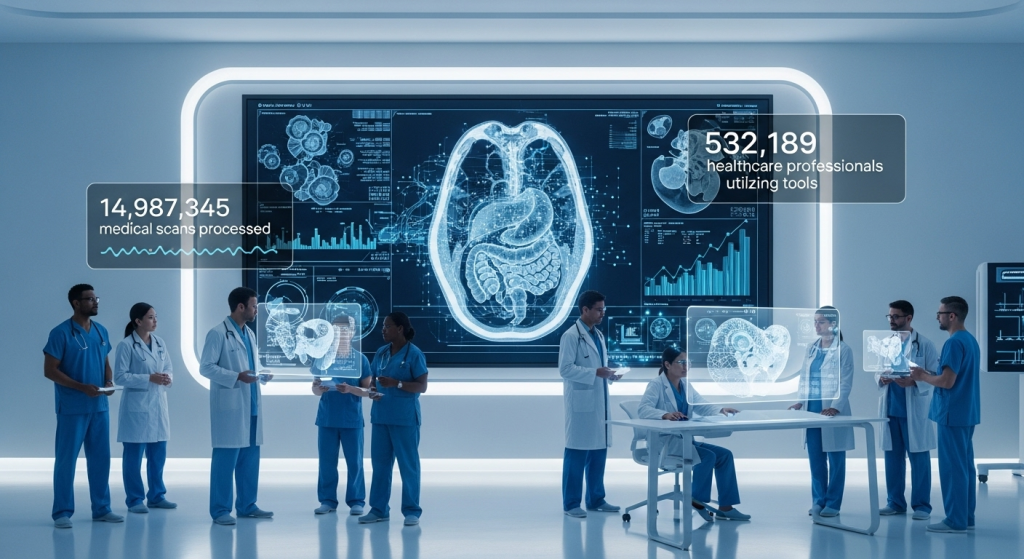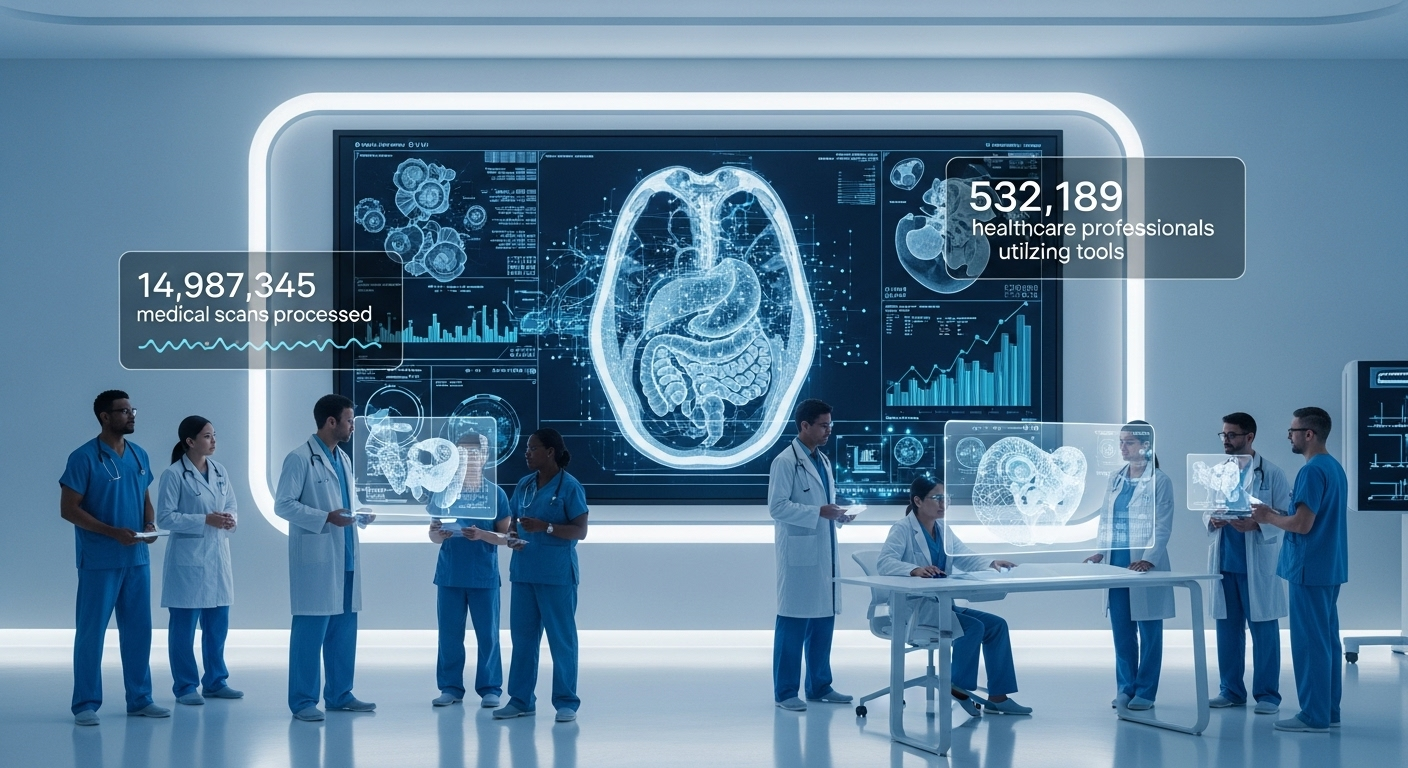Almost 15 million medical scans have been processed, and over half a million healthcare pros are using these tools, showing just how fast care systems are changing these days. This remarkable number highlights not only the volume of data being analyzed but also the growing reliance on advanced technology in the healthcare sector. As these tools become more integrated into daily practice, they enable healthcare professionals to make data-driven decisions, ultimately enhancing patient care and streamlining workflows, especially with the rise of AI in healthcare companies.

This shift is not a single gadget. It spans virtual primary care, rapid imaging triage, autonomous coding, and ambient documentation that frees clinicians to focus on patients.
Companies like RapidAI, Tempus, CodaMetrix, XpertDox, Imagene, and Augmedix illustrate how platforms turn clinical and molecular data into timely information at the point of care.
Expect faster diagnosis, lower costs, and better outcomes as technology embeds into emergency workflows and remote services. These solutions help health systems improve patient access and move care beyond clinic walls.
Across diagnostics, drug discovery, documentation, and virtual services, the goal is clear: use intelligence to support clinicians, protect safety, and make decisions that truly help patients.
Why AI Is Transforming Healthcare Right Now in the United States
Large-scale models, bigger compute, and richer datasets are rewriting how care teams make decisions today. The IIA panel summed this as the alignment of model scale, compute scale, and data scale. That convergence moves systems from slow, retrospective analytics to near real-time clinical support.
From data to decisions
Advanced machine learning and causal learning let doctors test “what if?” scenarios and compare treatment options faster. This shortens time to diagnosis for conditions where minutes matter and improves research-grade decision support at the bedside.
When EHR-agnostic software and interoperable systems connect payers, health systems, and vendors, friction drops and patient outcomes improve. Model outputs help tailor treatment to disease subtypes and individual context rather than an average patient.
- Automation reduces repetitive work and lowers utilization by catching problems earlier.
- Remote primary care and monitoring extend services beyond hospitals to triage conditions sooner.
- Information synthesis tools surface guidelines and adverse-event risks within clinician workflows.
Takeaway: Better models and technology only matter when they simplify care for doctors and patients, support safer decisions, and deliver measurable improvements across conditions.
AI in healthcare companies: A list of innovators changing patient care
A growing set of startups and established firms now deliver platforms that speed diagnosis, guide treatment, and ease clinician workloads.
Below are grouped leaders across imaging, research, documentation, and virtual care — each focused on practical impact.
Diagnostics and imaging leaders
RapidAI, Aidoc, and Viz.ai triage emergencies fast. Clearly, Rad AI and Eko Health boost cardiac reporting and accuracy for clinicians.
Drug discovery and research trailblazers
Tempus, Verantos, Generate: Biomedicines, Insitro, GNS, and Imagene connect clinical and molecular data to speed research and lower trial risk.
Clinical documentation and coding automation
Augmedix, Suki, CodaMetrix, and XpertDox cut documentation time and raise coding precision through ambient notes and automation.
Virtual care, RPM, and operations optimization
K Health offers 24/7 virtual primary access while Athelas and Cera enable remote monitoring and home-based services. LeanTaaS and Infinitus Systems optimize capacity and phone workflows.
Why this matters: Most platforms are cloud-based and API-driven. They integrate with existing systems to reduce disruption, support clinicians, and improve the patient experience from diagnosis to treatment.
| Category | Example Company | Primary Benefit | Integration Style |
|---|---|---|---|
| Imaging & Diagnostics | RapidAI, Aidoc | Faster triage and higher reporting accuracy | API + PACS, EHR connectors |
| Drug Discovery & Research | Tempus, Insitro | Faster target ID; reduced trial risk | Cloud datasets, analytics APIs |
| Documentation & Coding | Augmedix, CodaMetrix | Reduced clinician burden; improved coding | Ambient voice, EHR plugins |
| Virtual Care & Ops | K Health, LeanTaaS | 24/7 access; improved throughput | Telehealth platforms; scheduling APIs |
Standouts in Diagnostics and Imaging: Faster, more accurate decisions
Real-world deployments demonstrate that imaging software can transform raw scans into treatment-ready answers.
Faster reads matter: platforms triage emergencies and cut time to trblood-flowr blood‑flo, with conditions such as stroke and pulmonary embolism. That speed directly reduces harm where every minute counts.
RapidAI and Aidoc: Time‑critical triage
RapidAI’s Rapid platform handles CT and MRI to flag stroke, aneurysm, and PE. It has processed 14+ million scans and runs at 2,000+ hospitals across 100+ countries, showing how a single product can standardize diagnosis at scale.
Aidoc offers FDA‑ and CE‑cleared algorithms that prioritize stroke, PE, ICH, and other urgent findings. Its enterprise platform pushes alerts into radiology workflows so teams act faster and coordinate care.
Pathology, cardiac insights, and reporting automation
PathAI trains models on large, expertly annotated datasets to improve oncology diagnostics and support trial enrollment. PathAI Diagnostics moves those models into clinical settings where accuracy shapes therapy choices.
Clearly, Viz.ai, Rad AI, and Eko Health cover cardiac analysis, stroke coordination, reporting automation, and digital stethoscope screening. Together, they span the image‑to‑report pipeline and surface structured data back to EHRs.
- Integration with existing systems keeps results inside clinician workflows, reducing context switches.
- Continuous learning from diverse data improves sensitivity and specificity, but teams must validate performance locally.
- Start with a targeted condition (for example, stroke) and scale to adjacent indications for measurable outcomes.
Drug Discovery and Precision Medicine: From molecules to models
A new wave of platforms turns fragmented biosamples and records into research-grade evidence for precision treatment. These systems connect clinical and molecular data to guide choices at the patient level and design better population studies.
Tempus and Verantos: Real-world data meets precision therapy
Tempus links clinical records with molecular profiles to match patients to trials and tailor treatment plans.
Verantos converts messy health records into validated real-world evidence through projects with the FDA and NIH, helping payers and regulators evaluate new indications.
Generate: Biomedicines, Insitro, GNS: Machine learning to design and validate therapeutic.s
Generate: Biomedicines uses generative biology trained on millions of proteins to propose novel candidates.
Insitro applies machine learning to decode disease biology and prioritize targets. GNS uses causal learning to simulate “what if?” treatment effects and reduce trial uncertainty.
Imagene: Foundation models accelerating oncology biomarkers and trials
Imagene’s foundation model approach speeds biomarker discovery, shaving months off sample-to-insight timelines for oncology trials.
- Why it matters: Generative and causal methods reduce cost and risk by prioritizing targets and predicting response before expensive trials.
- Buyers should demand proof of impact — faster enrollment, fewer protocol changes, and verified outcomes that support coverage decisions.
- Platforms must ensure data harmonization, lineage, and auditability to meet regulatory expectations across the drug lifecycle.
Bottom line: Precision therapy succeeds when high-quality data, robust models, and transparent outcomes reporting come together to improve health outcomes.
Clinical Documentation, Ambient AI, and Coding: Giving time back to doctors
Ambient documentation and coding platforms are giving doctors back hours each week by turning spoken visits into structured records that flow into existing systems.
Augmedix and Suki: Ambient notes and voice assistants that reduce burnout
Augmedix converts clinician–patient conversations into structured notes and data, supporting nearly 500,000 clinicians. Suki uses voice assist to help clinicians document faster and with less friction.
CodaMetrix and XpertDox: NLP-driven autonomous medical coding at scale
CodaMetrix autonomously codes mid‑cycle across specialties, serving 200+ hospitals and 50,000 providers. XpertDox’s XpertCoding auto-codes >94% of claims at >99% accuracy while remaining EHR-agnostic and certified (HIPAA, SOC 2, ISO 27001, ISO 22301).
Abridged: Patient-centered summaries that improve understanding
Abridge creates clear visit summaries so patients and caregivers remember treatment plans, meds, and follow-ups. That clarity improves adherence and satisfaction.
- Workflow fit: These platform tools integrate with EHRs and revenue systems to minimize disruption.
- Operational impact: Autonomous coding boosts throughput, charge capture, and cash flow while keeping audit trails.
- Trust and safety: Certifications and resilient system design protect patient data and uptime.
- Learning loops: Human review for edge cases keeps accuracy high as coverage expands.
👉 “For healthcare companies or agencies looking to quickly deploy similar AI-powered platforms under their own branding, solutions like AIWhitelabels make it possible to launch custom healthcare AI tools with minimal setup.”
| Function | Example | Key metric | Integration |
|---|---|---|---|
| Ambient notes | Augmedix, Suki | Supports ~500,000 clinicians | EHR plugins, ambient voice |
| Autonomous coding | CodaMetrix | 200+ hospitals; 50,000 providers | Mid-cycle coding, audit logs |
| Auto-coding accuracy | XpertDox | >94% auto-code; >99% accuracy | EHR-agnostic; revenue system links |
| Patient summaries | Abridge | Improves recall and adherence | Visit export; patient portal |
Buyer tips: Evaluate latency, specialty coverage, error handling, and support response. The goal is better care with less clerical load—tools that assist doctors and help patients, not replace them.
Virtual Care, Remote Monitoring, and Care Delivery Models
Virtual care and home-based models now move routine medicine closer to where patients live.
“Consumers also benefit from AI-powered health tools, such as AliveCor’s KardiaMobile for heart monitoring or Lark Health for personalized chronic disease management, which complement hospital-driven AI solutions.”
K Health offers an AI-driven, 24/7 virtual primary care platform that pairs machine learning triage with clinician oversight. This shortens the time to diagnosis for many common conditions and expands access through health system and insurer partnerships across the U.S.
Athelas supplies connected devices for blood pressure, glucose, and weight monitoring. Continuous feeds and ambient transcription let care teams spot trends early and reach out before small issues escalate to hospitalization.
Cera and Sprinter Health bring diagnostics and visits into the home. Real-time monitoring, routing, and logistics improve adherence and remove barriers for patients with mobility or transport limits.

- Home device data flows into clinician dashboards and EHRs to inform decisions.
- Transcription tools capture visit details to keep records consistent across organizations.
- Virtual care complements clinics by routing patients to in-person follow-up when needed.
| Platform | Core Offer | Benefit | Integration |
|---|---|---|---|
| K Health | 24/7 virtual primary care | Faster access; reduced wait time | Mobile app; payer partnerships |
| Athelas | RPM devices + transcription | Early outreach; chronic care control | Device APIs; RCM links |
| Cera / Sprinter Health | In-home visits and diagnostics | Better adherence; equity gains | Logistics platform; EHR feeds |
Note: Evaluate EHR integration, patient onboarding, and reimbursement pathways like RPM codes. Success is measurable by fewer ER visits, improved condition control, and higher patient satisfaction, while protecting data and consent across the platform.
Hospital and Health System Operations: Scheduling, throughput, and automation
Hospital operations are improving as data-driven platforms smooth schedules and cut waste across services. These tools focus on capacity, timing, and predictable workflows to keep patients moving.
LeanTaaS: Capacity optimization for operating rooms and infusion centers
LeanTaaS uses historical data and machine learning to forecast demand and optimize block scheduling for ORs and infusion chairs.
This approach raises throughput without adding physical capacity. Fewer cancellations, more on-time starts, and higher chair utilization follow when schedules match real needs.
Infinitus Systems: Voice agents that streamline admin workflows
Infinitus Systems builds voice agents that automate payer and pharmacy calls. That automation shrinks hold times and trims manual follow-up, freeing staff for direct patient support.
- Integration: Both platforms push schedules and call outcomes back into EHRs and revenue-cycle software.
- Operational impact: Dashboards, alerts, and scenario tools help leaders make daily and weekly choices from reliable data.
- ROI: More on-time starts, fewer manual steps, and better drug prep timing reduce waste and improve safety.
👉 “Beyond hospital operations, healthcare marketing teams also rely on AI tools to optimize lead generation and outreach. Platforms such as LeadsMate AI can help clinics and health systems capture more patients and streamline communication with prospects.”
| Vendor | Core benefit | Measure |
|---|---|---|
| LeanTaaS | Forecasting & scheduling | On-time starts, chair utilization |
| Infinitus Systems | Automated payer/pharmacy calls | Reduced manual follow-ups, time saved |
Buyers should evaluate change management, vendor support, and security posture. When these products are embedded in current workflows, staff adopt them faster, and patient care improves.
Evidence, Safety, and Trust: Building responsible AI in healthcare
Trust and verified evidence are the foundation for any clinical system that supports real patient care. Platforms must deliver clear provenance and explainable recommendations before clinicians rely on them.
OpenEvidence: Synthesizing clinical evidence for point-of-care support
OpenEvidence aggregates and visualizes high-quality research so clinicians can view the studies behind a recommendation. That structure improves accuracy and speeds clinical use at the bedside.

Certifications and compliance: HIPAA, SOC 2, ISO—why they matter
Certifications like HIPAA, SOC 2, ISO 27001, and ISO 22301 show maturity in security, data governance, and continuity. They help organizations demonstrate readiness for clinical workflows and incident response.
Safety-first models: Hippocratic AI and the push for reliable LLMs
Safety-focused work from groups such as Hippocratic AI emphasizes guardrails, bias monitoring, and model versioning. Responsible systems include human oversight, audit logs, and post-deployment monitoring—especially for radiology and imaging applications.
- Require explainability and auditability for model outputs.
- Include patients and clinical leaders in evaluations.
- Favor vendors with transparent security docs and research partnerships that publish peer‑reviewed outcomes.
Bottom line: Responsible implementation is a continuous practice—from data collection to model retirement—to protect patients and improve outcomes.
How to Evaluate AI Healthcare Vendors: A practical buyer’s checklist
Picking the right vendor starts with clear evidence and practical proofs, not pitch decks.
Begin with clinical validation. Request peer‑reviewed studies, multi‑site results, and real-world outcomes that show improved diagnosis, treatment, and safety. Ask for published metrics from known deployments such as RapidAI (14M+ scans) or CodaMetrix (200+ hospitals).
Integration and interoperability
Confirm the platform is EHR-agnostic and has clear integration guides. Verify reference customers that run similar systems to reduce implementation risk.
Data governance and auditability
Insist on privacy, lineage, retention rules, and audit trails. Look for third‑party certifications like HIPAA, SOC 2, or ISO to protect patients and organizations.
Total cost, workflow fit, and time‑to‑value
Include vendor services, training, and change management in cost estimates. Test the product with frontline clinicians to ensure it reduces clicks and improves quality documentation.
- Model monitoring: Ask how drift, updates, and rollbacks are handled.
- Scalability: Confirm SLAs, concurrency, and uptime for mission‑critical use.
- References: Speak with peers running similar deployments.
| Checklist item | What to request | Example evidence | Why it matters |
|---|---|---|---|
| Clinical validation | Peer review, multi-site studies | RapidAI, Aidoc, Verantos demos | Shows real impact on diagnosis and treatment |
| Integration | EHR-agnostic APIs, guides | CodaMetrix, Augmedix references | Reduces implementation risk |
| Governance | Audit logs, retention policy | XpertDox certifications | Protects patient data and trust |
| ROI & support | Cost model, training plan | Customer case studies | Accelerates adoption and use |
Conclusion
Across hospitals and home care, new platforms turn complex records into clear, actionable guidance for doctors and patients.
These solutions span discovery, radiology, imaging, documentation, remote delivery, and drug research. They work best when accuracy, transparency, and governance protect privacy and build trust.
“From hospital platforms to consumer-facing AI health devices like AliveCor, the AI revolution is empowering both clinicians and patients.”
Buyers should pilot a focused use case, apply the buyer checklist, measure against baseline benchmarks, and scale what proves safe and effective. Continued research partnerships and rigorous validation will keep technology advancing toward better care for every patient.








